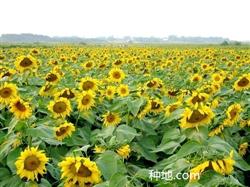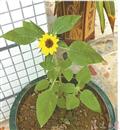What is there to pay attention to growing sunflowers?

What do you need to pay attention to growing sunflowers? There are ten points to pay attention to when planting sunflowers: first, rotation should be reasonable and stubble should be selected. Sunflower is not suitable for continuous cropping and planting in low-lying land prone to waterlogging, and the selection of previous crop is not strict. Except sugar beet and deep-root forage, other crops can be used as the first crop of sunflower. Sunflower has strong adaptability and is the most suitable for planting in sandy loam or loam soil with deep soil layer and high PH value of 6-8. Second, select excellent varieties and deal with them. Third, apply sufficient base fertilizer and tamp the foundation. Fourth, catch early before the robbery and broadcast early at the right time. Timely early sowing can prevent or reduce the occurrence of leaf spot and Sclerotinia sclerotiorum, and have a great impact on the yield and quality of sunflower. Fifth, reasonable close planting is beneficial to ventilation. Sunflower stalk tall, stem thick, should be reasonable close planting, conducive to ventilation and light transmission, improve photosynthesis. The principle is that tall stalk and large grain varieties should be sparse, dwarf and small grain varieties should be dense, oil type varieties should protect 25000-30000 seedlings per hectare, and edible varieties 18000-20000 plants per hectare. Sixth, strengthen ploughing and topdressing at the right time. Early thinning and early setting of seedlings, when the seedlings grow to two pairs of straight leaves, fix the seedlings; from emergence to bud stage, carry out 2-3 times of intermediate ploughing and weeding; the last time, deep ploughing and soil cultivation should be done to prevent toppling, but it should be noted that the roots should not be hurt. Topdressing should be both timely and reasonable. From budding to flowering, sunflowers should be topdressing 150 kg of urea per hectare, ditch or hole application, and spraying 0.2% 0.4% potassium dihydrogen phosphate at full flowering, depending on the growth, once or twice. 7. According to the growth trend, fork in time. During the period from budding to flowering, sunflower often bifurcates. Once found, the bifurcation is removed immediately to reduce the consumption of water and nutrients and ensure the nutrient and water needs of the main stem disk. Eighth, adjust measures to local conditions and irrigate scientifically. In the sunflower disk formation stage, flowering stage and filling stage, timely and appropriate amount of scientific irrigation, especially in case of drought, should be timely irrigation to meet the water needs of sunflower in the growth and development stage. Forecast, disease prevention and pest control. It is necessary to do a good job in the prediction and forecast of diseases and insect pests, and once they occur, we should immediately prevent and cure them, and strive to cure them as soon as possible. Assist in pollination to improve fruiting. Sunflower is a cross-pollinated crop, which is pollinated by insects and bees. in spite of this, artificial pollination should be carried out at about 10:00 every morning (9 am to 11:00), usually 2-3 times. More sunflower planting techniques
- Prev

How to control underground pests by planting sunflowers?
How to control underground pests when growing sunflowers? The main underground pests of sunflower are mole cricket, grub, ground tiger, golden needle worm and other underground pests. The control measures are as follows. (1) Agricultural prevention and control. ① uprooted weeds in the field and buried or transported weeds in time before sunflower emergence or during the peak period of 1st and 2nd instar larvae.
- Next

How to grow sunflowers in the basin?
How to grow sunflowers in the basin? Sunflowers used for potted plants have a short growth period and can blossom in about 50 days. At the same time, ornamental sunflowers suitable for potted plants, such as' vigor', 'Happy Dwarf', 'Beibei Bear' and 'Golden Monica', have more branches and can produce many fresh flowers one after another.
Related
- The first cup of black tea in spring, the flavor and history of tea gardens in Kenya, Africa
- The computer can not only choose potatoes, but also grow tea rice. AI will grow winter oolong tea champion.
- It is not only the inflated tea bitten by insects, but also engraved with the four seasons tea in Beipu.
- The Oriental Beauty Tea Festival in Zhuxian County takes the stage at the weekend to experience the plus-size feast of oil tea.
- & quot; Oriental Beauty Tea & Exploration of Emei in Hsinchu, the hometown of quot;
- The new variety of strawberry "Tainong 1" dessert is the first choice with mellow aroma. Crimson gorgeous
- History of Tea in Taiwan: from Wild Inner Mountain to Export Tea Garden
- Two types of Taiwan Oriental Beauty Black Tea won the British three-Star Award for Childhood Tea Xiang Zhang Jiaqi changed from pilot to champion tea maker.
- Banana species and varieties: the planting history of Taiwan Xianren banana and dwarf banana is long, is banana disease resistant?
- Coffee planting Technology: Qianjie Coffee from Seedling to harvesting

